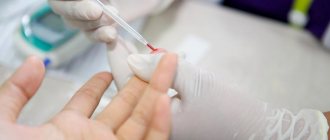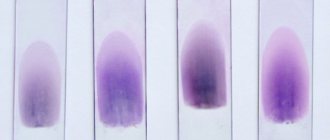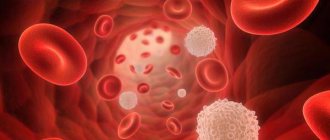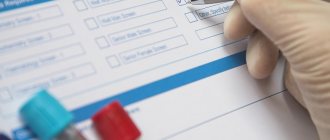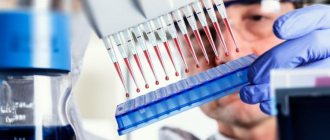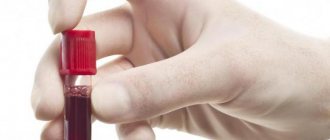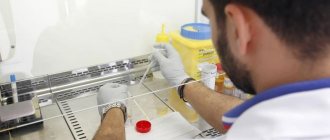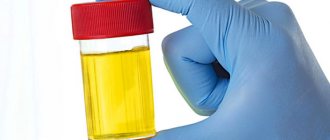Decoding
The attending physician deciphers the general blood test. Of course, with the easy access to general tables of normal indicators that exist today, you can try to interpret the data yourself. However, this should not be done, since the specialist who prescribed this examination evaluates not just the level of content of this or that parameter, but includes them in the overall clinical picture and compares them with other symptoms that the patient has:
- Hemoglobin, Hb - in women the normal value varies in the range of 120 - 140 g/l, in men - 130 - 160 g/l. An increase in hemoglobin levels may indicate dehydration of the body, various intestinal infectious diseases, and heart defects. A decrease indicates the development of anemia.
- Blood color index, CP - normal level is 0.85 - 1.15%. A decrease in the level of the color indicator of the blood indicates the development of anemia; an increase may accompany a violation of the synthesis of folic acid and oncological processes.
- Red blood cells - in women the norm is in the range of 3.7 - 4.7 g/l, in men - 4 - 5 g/l. An increase in the content of red blood cells can be observed both with minor disorders (diarrhea, burns, use of diuretics), and with the development of cancer and kidney pathologies. A low level indicates the development of anemia, blood loss, and the formation of edema.
- Erythrocyte sedimentation rate, ESR is a normal indicator in women - up to 20 mm/hour, in men - up to 15 mm/hour. Increased rates are observed in inflammatory and autoimmune pathological processes, cancer, disorders of the endocrine system, kidneys and liver. A decrease in indicators is characteristic of circulatory failure.
- Leukocytes - regardless of gender, the norm is 4 - 9 * 109 / liter. An increase in the level of leukocytes in the blood is observed during infectious processes; a decrease accompanies the development of cancer and hepatitis.
- Platelets - responsible for, normally - 180 - 320 * 109 / liter. High platelet counts are observed in rheumatoid arthritis, various forms of tuberculosis, and oncology. A decrease in platelet levels accompanies autoimmune diseases and anemia.
How to take the material
How is a general blood test taken? There are two ways to collect material for human blood testing:
- A rapid test to determine the amount of hemoglobin in a patient’s blood. This method also allows you to determine the level of ESR. Typically, express research is carried out when there is an urgent need to obtain results. Such a case may occur during emergency hospitalization and preparation of the patient for surgery.
- A routine blood draw in a laboratory allows you to find out how much red and white cells, red and white cells, red blood cells, white blood cells and other trace elements are contained in a person’s blood.
Description of the procedure
How do they take a general blood test from a baby who is not yet sitting? The main goal of the specialist is to obtain liquid from the finger. To do this, he will have to apply maximum effort.
Features of blood sampling in newborns
They take blood from babies at 2 months, where it comes from. Usually punctures are made in the ring finger of the left hand. If the baby clenches his hands tightly into fists, then the big toe or the area next to the heel is pierced. Manipulation occurs according to a certain algorithm:
- Prepare the workplace.
- Wash your hands and treat them with alcohol.
- Put on gloves.
- Coat the puncture area with cotton wool.
- An injection is made with a children's scarifier.
- The sampling is carried out using a special capillary with a bulb.
- The newborn's finger is clamped with a cotton swab.
Not all clinics have scarifiers for children, so adults use them. If the medical institution does not have them in stock, you can purchase a needle at the pharmacy. Laboratory assistants will not refuse parents and will carry out the procedure.
Where is blood taken?
If blood is taken from a vein according to indications, the nurse can take a test tube and pour some liquid into it for a general analysis. Some doctors do not see the difference between venous and capillary blood. Although it exists between them, although it is not significant.
The material is collected in a specially designated room. It's called "Laboratory". It is equipped with places for receiving patients, with all the necessary items and materials. There is a separate box of gloves on the specialist’s desk. After each patient, the laboratory technician is required to change gloves, sanitize the work surface and wash his hands.
The boy's blood is taken
What materials are used
To take fingerprint analysis, the following tools and materials are used:
- sterile cotton wool;
- antiseptic;
- scarifiers;
- glass capillaries;
- rubber bulb;
- laboratory glass;
- disposable gloves.
In children's medical institutions, they strictly monitor the availability of materials and compliance with the sanitary and epidemiological regime. Parents have nothing to worry about.
How to squeeze your finger so it doesn't hurt
To prevent pain for the child, the finger is pinched before the puncture. This is usually done by a specialist. In some cases, parental assistance may be needed. The ring finger of the left hand is first rubbed with the fingers so that there is a flow of blood. It should warm up. With your left hand, pinch your finger at the bend of the phalanx and make a sharp puncture. The faster the needle pierces the skin, the less pain the newborn will feel.
How long to wait for the research result
A clinical analysis is prepared within a working day, if there are no problems with the equipment, but no more than a week. The erythrocyte sedimentation rate is 1 hour. Laboratory technicians recheck results that raise suspicions manually.
A complete blood count shows the overall health of the child. Parents are concerned about the blood sampling process. Children under one year old will not remember the pain, so there is no need to worry. Some babies may not wake up at all during the procedure. What causes anxiety in children is no longer the process of taking the test, but the unusual surroundings and unfamiliar people.
Fence algorithm
To work, the laboratory assistant must prepare:
- sterile scarifier;
- cotton wool;
- alcohol;
- tincture of iodine;
- ether.
Disposable scarifier - a tool for pricking a finger
The algorithm and technique for taking are as follows:
- The patient sits opposite the laboratory assistant. The hand (usually the left) lies on the table.
- The puncture site is disinfected with alcohol and degreased with ether.
- Using a disposable scarifier, a puncture is quickly made in the pad of the ring finger, immersing the tool to the full depth of the cutting part (approximately 2-3 mm).
- The first drop of blood is removed using dry cotton wool.
- For the study, use the second and subsequent drops of blood, which are collected using a glass adapter, then placed in test tubes and signed.
- After the blood has been taken, the injection site is treated with alcohol or iodine and clamped with a cotton swab until the blood stops completely.
The algorithm for collecting capillary blood from a child is exactly the same as from an adult.
Arterial blood sampling
Indications for taking arterial blood are limited:
- blood gas analysis;
- blood culture if fungal sepsis is suspected.
Preparation
Taking venous blood.
Puncture site: radial, femoral, posterior tibial arteries.
Patient position: (venous blood collection), during femoral artery puncture, the patient is held by two staff members, if necessary.
Carrying out
The blood is drawn by a doctor; Care should be taken as streams of blood (BP) may splatter.
Observation after the manipulation
Compress the injection site: first for 5-10 minutes with your hand (with gloves!), then with a compression bandage.
Control the occurrence of bleeding.
Observe blood flow in the limb, temperature and color of the skin, pulse, sensitivity, and take into account complaints of pain.
Determining the blood formula - why is it needed?
Laboratory research allows you to determine the approximate number of formed blood cells, which makes it possible to determine the general condition of the body. After all, it’s no secret that almost any disease entails a change in the blood formula
What exactly do laboratory technicians and doctors pay attention to?
- The number of leukocytes is counted, as well as a differential analysis (the number of basophils, eosinophils, neutrophils, monocytes and lymphocytes is determined). The number of white blood cells increases in the presence of infection and inflammation, and changes in the level of each type of these cells indicate a particular problem.
- In addition, hemoglobin levels and red blood cell counts are measured. For example, a decrease in the number of red blood cells may indicate anemia.
- Platelet counts help determine the presence of some bone marrow diseases and may also indicate a disorder
Analysis results
You can find out how much analysis is done immediately before donating blood. Typically, the duration of the study is from 5 to 7 days .
In private clinics, the result is ready within 3-5 days after the collection procedure. If you get bad results, you should remember the following:
- The possibility of error cannot be ruled out
- The reliability of the result depends on how correctly the medical worker takes the blood,
- Violation of the rules for preparing for analysis leads to an incorrect result,
- Before the procedure, do not rub your fingers. The resulting result will include increased white blood cell counts,
The results are interpreted by the attending physician. Self-medication is strictly prohibited.
General blood test norms
As a result of the analysis, data on the following parameters are presented:
- Hemoglobin,
- red blood cells,
- Reticulocytes,
- platelets,
- ESR,
- Leukocytes,
- Monocytes,
- Lymphocytes,
- granulocytes,
- color index,
A person who has passed a general analysis has a question about what result should be feared.
The following situations indicate the presence of serious diseases:
- Drop in hemoglobin level
- Increase in ESR,
- Increase in the number of leukocytes,
- Reduction of red blood cells,
How long are the results valid?
Each of the blood tests has a certain expiration date, which doctors rely on when they need to check a person’s health status, for example, during a preventive examination or after a therapeutic course. For ordinary people not related to medicine, it is also important to know how long blood tests are valid, so as not to visit the laboratory again without a special reason.
The validity period of the examination results is as follows:
- UAC – 10–14 days;
- BAK – 10–14 days;
- immunological – 2 months;
- coagulogram – 6 months (in a healthy person).
Reference! Sugar test results are valid depending on the patient's condition. A healthy person after 40 years of age needs to be examined every six months, while a diabetic determines the glucose level several times a day.
Advantages
- Using a lancet does not cause pain to the child and does not leave bruises. The strength and depth of the puncture does not depend on the pressure on the finger of the nurse or parent.
- The instrument is completely sterile and packaged in a sealed container, which is opened immediately before the procedure. Before packaging, all lancets are treated with gamma radiation.
- The procedure using the lancet lasts only a few seconds.
- Blood test results will be more reliable. Emotional experiences when piercing a finger with a conventional scarifier can affect the effectiveness, so using a lancet will help avoid mistakes. In addition, the blood does not come into contact with air after collection.
- The Lancet can be used at home to easily test your glucose levels (using a glucometer).
How to prepare
Recommendations
To get tested, come to the hospital in the morning (usually from half past eight to eleven in the morning). Many patients are interested in the question: is it possible to eat before donating blood? As you know, blood fluid collection should be performed on an empty stomach. You are only allowed to drink plain water. The interval between the last meal and blood donation should be at least 10 hours.
The day before the procedure, you can only eat light food. The fact is that eating foods that are too fatty and hard on the stomach, especially before bed, will lead to the analysis showing poor results. When preparing for the study, you should not drink alcohol-containing drinks.
Important! Before taking the test, patients should try to avoid mental and physical stress. Smokers should forget about this habit in the morning before going to the laboratory.
The analysis cannot be taken if a week has not passed after such procedures: radiography, radiation, chemotherapy.
For children the rules are more flexible. Parents often wonder whether children need to donate blood on an empty stomach? You should not refuse to feed a newborn baby or infant. In addition, formula and breast milk are quickly absorbed and will not lead to a large difference in the analysis parameters.
Algorithm for collecting capillary blood: rules and techniques for collecting blood from a finger
Clinical analysis of capillary blood includes determination of hemoglobin concentration, number of erythrocytes, leukocytes and platelets, hematocrit and erythrocyte indices (MCV, RDW, MCH, MCHC), blood formula (percentage of different types of leukocytes (neutrophils, lymphocytes, eosinophils, monocytes, basophils)). Additionally, if necessary, the erythrocyte sedimentation rate (ESR) is measured.
During medical examinations and clinical examinations, glucose levels are measured using capillary blood and rapid tests of cholesterol levels are performed.
Preparing for the study
The procedure is carried out in the morning, usually from 8.00 to 10:00, on an empty stomach: the previous meal the night before should be at least 12 hours before taking. In the morning on the day of the study, you can only drink water.
A few days before the test, it is advisable to exclude fatty foods and alcohol from the diet. It is also recommended to temporarily limit physical activity, get enough sleep if possible and avoid stress. Smoking is highly discouraged before the procedure.
Tool
The finger is pierced with a disposable sterile scarifier - this eliminates the risk of infection. The size of the needle or blade is selected individually, depending on the age and physical (physiological) characteristics of the patient. Modern automatic scarifiers reduce both pain and anxiety for the patient.
Choosing a blood collection site
Choose a non-cooled, non-cyanotic, non-edematous finger. The puncture is best done at the tip of the fourth finger of the left hand (for right-handed people). Fingers II and III can be pierced.
If the patient’s hands are cold, then before performing the puncture they need to be wrapped in a fairly hot towel for 10-15 minutes. To increase blood flow, gently massage the finger from base to tip.
Using a swab moistened with alcohol, carefully treat the tip of the finger and allow the surface to dry.
In newborns and children under 1 year old, capillary blood is collected from the heel. The method of taking blood from the heel is in many ways similar to the method of taking blood from the finger. A deep heel injection is performed at the distal edge of the heel bone, after preheating the foot in warm water
The procedure for taking capillary blood from a finger
- Prepare the necessary equipment on the manipulation table.
- Identify the patient, introduce yourself, announce the progress and purpose of the procedure. Make sure that the patient has informed consent for the upcoming procedure. If this is not the case, check with your doctor for further steps.
- Label the tubes, indicating the patient’s name and department (in order to eliminate errors in identifying the biomaterial sample).
- Treat hands hygienically and dry.
- Treat your hands with antiseptic.
Do not dry, wait until the antiseptic has completely dried - Wear non-sterile gloves
Technique for collecting capillary blood from a finger
- Soak a cotton ball (gauze) in an antiseptic.
- With one hand, take the 4th finger of the patient's free hand, massage it lightly, pinching the upper phalanx of the finger with the index and thumb.
- With the other hand, treat the inner surface of the upper phalanx of the patient’s finger with an antiseptic with a cotton ball (gauze) soaked in an antiseptic. Dry the surface of the finger with a dry sterile cloth (cotton ball).
- Place the used napkin (ball) in the consumables tray.
- After the skin has dried, take a scarifier and puncture the skin with a quick movement.
- Place the used scarifier in a puncture-resistant waste container.
- Wipe off the first drops of blood with a dry sterile cloth (cotton ball). Place the used napkin (ball) in the consumables tray.
- By gravity or using a capillary, collect the required amount of blood. The volume of blood drawn must correspond to the mark on the tube.
- Press a napkin (cotton ball) with an antiseptic solution to the puncture site. Ask the patient to hold a napkin (cotton ball) at the puncture site for 2-3 minutes.
- Invert the tube into a vertical position to transfer blood from the capillary to the tube.
- Turn the cap off the tube, remove it, and place it in a puncture-proof container along with the built-in capillary without disassembling it.
- Remove the cap from the base of the test tube, tightly close the test tube or close the test tube with a cap until it clicks (depending on the modification of the test tube).
- Mix the sample thoroughly by inverting the test tube.
Source: https://corway.ru/materialy/algoritm-zabora-kapillyarnoj-krovi/
Manufacturers
Lancets, which are used to painlessly take blood samples from children, are represented by the following models:
1. Automatic lancets Medlance Plus from the Polish company HTL-Strefa Inc. They are presented in several types with different body colors - lilac devices are suitable for children (needle penetration depth is 1.5 mm), and blue ones are universal (with a needle 1.8 mm long).
2. Lancets from Qlance. This Chinese manufacturer offers devices for children with a penetration depth of 1.8 mm. In a purple lancet, the needle diameter is 0.45 mm, and the volume of blood taken is up to 100 μl. In a blue lancet, the needle has a diameter of 0.8 mm. With this device, 100 to 150 μl of blood is collected.
3. Automatic lancets MR. These are also Chinese-made devices with a triangular thin tip. For children, lancets with a puncture depth of 1.8 mm are produced - pink and yellow.
4. Scarifiers of the Vitrex Sterilance Lite II series. Children can draw blood with orange lancets from this brand, the puncture depth of which is 1.8 mm.
5. PROLANCE lancets. This company's assortment includes lancets with a puncture depth from 1.4 to 1.8 mm in blue, blue, yellow and green, also differing in needle diameter.
6. Mini Collect lancets. Purple lancets from this manufacturer with a puncture depth of 1.25 mm are intended for children.
7. Acti-Lance devices. The needle of this company's purple lancet pierces the baby's skin to a depth of 1.5 mm. You can also use the universal blue Acti-Lance lancet with a puncture depth of 1.8 mm.
8. Bd Microtainer lancets. Lilac devices pierce the child's skin to a depth of 1.5 mm, and pink ones - to a depth of 1.8 mm.
The range also includes lancets for infants up to one year old, which can be used to draw blood from the heel.
Video Biochemical blood test transcript, table and norm
Despite the fact that the general analysis shows less information, it also has its advantages.
These include the following:
- High speed of the procedure;
- Only pierce the skin surface. The depth of the wound does not exceed 3 mm;
- The fence rules are much easier to follow. This increases the reliability of the result;
- Capillary biomaterial is tested much faster than venous blood;
- In private clinics, the price for a general analysis is lower than the cost of a biochemical analysis;
Doubts regarding your health sooner or later make you wonder how and where to take a general blood test.
The answer to this question depends on the patient's requirements and capabilities. There are three possible options:
- State clinic;
- Private clinic;
- Medical personnel visiting your home;
In the first case, the diagnostic procedure is carried out within the framework of health insurance. The analysis is absolutely free . The disadvantages of donating blood at a government institution include long queues and the procedure being carried out at a strictly fixed time. It takes more time to examine a blood sample, which cannot be said about private clinics.
You can take the test at a paid institution at any convenient time. The main condition is not to eat for more than 3 hours. It costs more to have a medical professional visit your home. The advantages of the service include the absence of the need to leave the walls of the house, which is especially important if the patient is seriously ill.
You can find out how much analysis is done immediately before donating blood.
Typically, the duration of the study is from 5 to 7 days .
In private clinics, the result is ready within 3-5 days after the collection procedure. If you get bad results, you should remember the following:
- The possibility of error should not be excluded;
- The reliability of the result depends on how correctly the medical worker takes the blood;
- Violation of the rules for preparing for analysis leads to an incorrect result;
- Before the procedure, do not rub your fingers. Ultimately, the result will include increased white blood cell counts;
The results are interpreted by the attending physician. Self-medication is strictly prohibited.
General blood test norms
As a result of the analysis, data on the following parameters are presented:
- Hemoglobin;
- Red blood cells;
- Reticulocytes;
- Platelets;
- ESR;
- Leukocytes;
- Monocytes;
- Lymphocytes;
- Granulocytes;
- Color index;
A person who has passed a general analysis has a question: what result should he be wary of?
The following situations indicate the presence of serious diseases:
- Fall in hemoglobin level;
- Increase in ESR;
- Increased white blood cell count;
- Reduction of red blood cells;
Why do they take blood from a finger? Purpose of the procedure
Blood from a finger test allows you to diagnose sugar levels, the number of platelets, red blood cells, leukocytes and other blood cells. Decoding the data allows you to determine the presence of inflammatory processes.
A finger prick blood test helps identify various pathologies: bleeding disorders, anemia, leukemia, infectious diseases. If a malfunction occurs in the body, this is always reflected in the composition of blood cells. After treatment of any disease, a finger prick blood test is also prescribed to monitor and ensure the effectiveness of treatment.
Such an analysis is always given during pregnancy to assess the condition of the fetus and the mother’s body. The woman experiences significant stress, so some values may deviate from the norm, but this does not always indicate pathology.
Each of the analysis indicators has its own meaning.
The purpose of the procedure depends on the age and condition of the patient. For children and adults, a blood test is performed to determine the child's general condition. The procedure may have a simplified or expanded version.
How to take blood from a finger
On the day of the study, the patient comes to the medical facility early in the morning. He sits down opposite the laboratory assistant and puts his hand on the table. Next, the laboratory assistant treats the pad of the ring finger with an antiseptic and lightly dries it with dry cotton wool. Then the laboratory assistant punctures the finger with a disposable needle 2-3 mm.
The first drop of blood is removed with a cotton ball, and the next drops are collected into a special adapter.
During the procedure, the finger should not be squeezed, as blood may mix with tissue fluids and, as a result, the analysis will be unreliable.
The blood is placed in a test tube, which is pre-labeled.
After drawing blood, a cotton pad moistened with an antiseptic is applied to the puncture site. You need to hold it for about 5-7 minutes until the bleeding stops. This procedure is carried out for adults and children over one year old.
For newborn children, the procedure is slightly different. The puncture is made not on the toe, but on the side of the heel. To reduce pain in a child, automatic sterile lancets are used. The result can be found out on the day of blood donation, in some cases after 1-2 days.
How to prepare for the procedure
Before donating blood from your finger, you need to prepare for the procedure. This is necessary in order to obtain reliable information
It is important to remember that results may vary under certain conditions.
Basic recommendations when preparing to take blood from a finger:
- Do not eat before the test. In the morning you can only drink water. Dinner should be no later than 8-10 hours before the procedure.
- The day before, you should avoid eating smoked, fried and spicy foods. All this affects the test results.
- The day before blood sampling, you need to avoid physical activity.
- Serious emotional shocks must be avoided.
- You must notify your doctor and laboratory technician about long-term use of medications. It is important to know that some medications can be stopped the day before the test, while others can be stopped a week before. The results may be affected by taking the following medications: antibiotics, aspirin, multivitamins, oral contraceptives, etc.
- It is not recommended to smoke a few hours before the test.
- It is not advisable to conduct ultrasound, MRI and other instrumental methods 24 hours before a blood test. They are safe, but radiation, ultrasound or electromagnetic radiation can have different effects on blood cells.
- Physiotherapy procedures may affect the clinical analysis, so it is better to carry them out after blood sampling.
- If a blood test is ordered while a woman is menstruating, the GP should be notified. It is also necessary to inform the doctor about the onset of pregnancy and menopause.
diagnosislab.com
In children
There are many reasons for performing blood tests in children. This includes not only the diagnosis of a specific disease, but also routine medical examination of children, as well as a preventive examination on the eve of registration in a kindergarten or school.
Preparation for drawing blood from a finger from children has a number of its own characteristics.
General recommendations in this case for parents are as follows:
- Blood donation should be organized in the morning on an empty stomach - from 7:00 am to 10:00 am.
- Provide the child's last meal 12 hours before the test.
- Any physical activity should be excluded from the child the day before the examination.
- Before the examination, medical personnel should be informed about all medications that the child is taking.
During this clinical examination of a child, medical workers rely on the following rules:
- The maximum volume of blood taken for examination is calculated depending on the age and weight of the child, as well as individual anatomical features.
- Blood is collected from a child over 1 year of age from the lateral surface of not only the ring finger, but also the middle finger. At the same time, to increase the speed of blood flow and eliminate the need to squeeze the finger, its surface should be warmed immediately before the puncture.
- In children whose weight is less than 9 kg, as well as for collecting blood from infants, the lateral surfaces of the heel are used, since there are a lot of vessels in it, and, on the contrary, there are practically no nerve endings. These features minimize pain in the child during the procedure. For better blood supply to the heel, it needs to be warmed before puncture.
Why is blood taken from the ring finger? Human Anatomy
The structure of the human hand is designed in such a way that if any infection enters the human body through the ring, middle, or index finger, then it spreads only there for a certain time. As for the other two, namely the thumb and little finger, the infection will directly spread to the hand. If an infection gets into the hand, it can spread to the arm. As a result, infection of the entire body can occur.
Why is blood taken from the ring finger from an anatomical point of view? The fact is that the nameless one is less involved in any functions. Therefore, blood is taken from it. When the finger is not exposed to any external influences, it heals faster. The ring finger is not particularly active. Namely, he is minimally involved in processes such as typing text on the keyboard, writing, etc. The wound on it will heal faster than on the index or middle finger.
How to prepare properly
The analysis will show a reliable result only if you prepare for it correctly. Is blood donated on an empty stomach or not? Treatment rooms in government institutions are open strictly in the morning. You cannot have breakfast before taking blood. In private clinics you can donate blood at any time.
The main principles of preparing for blood collection are as follows:
- The day before, he recommends avoiding foods rich in fat;
- 1-2 days before donating blood, you should not drink alcohol;
- Immediately before visiting the treatment room, you should refrain from smoking;
- It is recommended to avoid stressful situations and physical activity the day before;
Where can I donate blood for testing?
You can undergo blood diagnostics using various methods in almost any city. Of course, laboratories and diagnostic centers in Moscow and other large cities have all the tests that are available today. But simpler ones can be taken at clinics in any region of Russia.
In addition, most laboratories offer express methods that are carried out very quickly - 1-2 hours, which allows the patient not to wait long for answers, but to begin treatment as quickly as possible. Such a service is, of course, not cheap, but sometimes the patient’s condition or the need to obtain an urgent certificate completely justifies the money spent.
Carrying out
There are two options for performing a general blood test:
- In the case of the first, laboratory assistants do an abbreviated analysis, which displays only the level of hemoglobin, blood cells and determines the erythrocyte sedimentation rate, that is, ESR.
- The second option involves conducting a detailed blood test, which also covers indicators such as hematocrit, average hemoglobin content in an erythrocyte, quantitative and qualitative composition of leukocytes, average erythrocyte volume and others.
When scheduling a clinical examination, the patient may have a question regarding what is used to prick the finger when blood is taken from it. Due to the increased risk of infection with blood-borne diseases, primarily hepatitis and AIDS, in modern laboratories over the past decades, only disposable instruments have been used to collect biological material, which are removed from the packaging, which is opened in front of the patient.
To directly pierce a finger, devices such as scarifiers, sterile needles, and lancets for piercing a finger are used. If you use the first two, the puncture is more painful.
Today, laboratory technicians are increasingly inclined to use modern automatic instruments in which the lancet is placed inside a plastic case.
Disposable scarifier
The advantages of scarifiers are safety, smaller needle sizes (helps reduce pain), ease of use, automation of the process (thanks to the trigger device, accidental release of the blade is excluded), as well as the psychological factor (the patient, not seeing the needle, worries less).
Purpose of analysis
This finger prick blood test is aimed, first of all, at determining the average level of hemoglobin in the blood; in addition, thanks to this study, laboratory assistants count the number of blood cells (erythrocytes, platelets and leukocytes), the color index of the blood, as well as the erythrocyte sedimentation rate (ESR) . All this makes it possible to diagnose in a patient such pathological processes in the body as various types of anemia, suspicion of helminthiasis, the presence of an inflammatory or malignant process.
Methodology
The reliability of the obtained result is influenced, first of all, by ensuring compliance with the rule of taking blood from a finger from children and adults (capillary blood). In order to minimize inaccuracies in the results, the influence of external factors on the body should be excluded. Blood is donated on an empty stomach in the morning, when the patient has not yet eaten anything (it is advisable that the last meal be 8-10 hours before the test), has not taken any medications, and also before other diagnostic procedures and physical activity.
Capillary blood collection technique
Also, the correctness of the result depends on the accuracy of following the algorithm for taking blood from a finger:
- Respecting the patient's rights to information, inform him about the progress of the subsequent procedure, obtain the patient's consent for its implementation.
- Prepare the necessary equipment for examining blood from a finger on the hand (cotton balls - dry and moistened with 70% ethyl alcohol solution, sterile disposable scarifiers - spears or sterile needles, labeled sterile disposable pipettes, clean slide (watch) glasses or, instead, clean plastic tablets, labeled clean test tubes with an anticoagulant, a container with a disinfectant solution for soaking waste material).
- Carry out hygienic and antiseptic treatment of hands, wear clean gloves.
- Treat the ring finger of your left hand with a sterile cotton ball moistened with a 70% solution of ethyl alcohol.
- Using a sterile scarifier or a sterile needle, make a puncture 2–3 mm deep (if the puncture is deeper, it will be more difficult to stop the bleeding).
- Wipe off the first drop of blood that appears with a sterile dry cotton swab.
- The next few drops of blood (at least 3 - 4) are dropped by gravity onto an individual glass slide (pressing on your finger to obtain blood is prohibited, since the blood is mixed with tissue fluid, and the analysis results may be distorted).
- Using a disposable sterile pipette, take 6–8 drops of blood, then carefully move it into a labeled tube with an anticoagulant. Blood can be drained into a test tube by gravity.
- Using the test tube in a circular motion (at least 10 times), thoroughly mix the collected blood with the reagent.
- Press a sterile cotton ball moistened with a 70% ethyl alcohol solution to the finger at the puncture site and advise the patient to hold it until the bleeding stops completely.
- Place the marked glass slide on a special table for analysis, and place the marked test tube in a special rack.
- To maintain infection safety, soak all used consumables in a container with a disinfectant solution.
Scarifier, needle or lancet
Devices for collecting blood from a finger, in addition to the well-known scarifiers and sterile needles, also include a lancet - a device that, thanks to its special design, minimizes skin damage and pain at the site of a finger puncture. A lancet for drawing blood from a finger looks like a sterile needle, which is tucked into a body made in the form of a plastic handle and is a replaceable element.
Lancet for blood collection
The advantages of using a lancet to draw blood from a finger are as follows:
- psychological factor - the patient does not see the needle because it is hidden in a plastic case;
- compliance with infection safety - lancets are sterile and disposable;
- the skin puncture area is significantly smaller than when using a scarifier or a sterile needle;
- Due to the reduction in the area of skin puncture, this device allows blood sampling from a finger with virtually no pain, so the lancet is a priority when conducting research not only in adults, but also in children, including newborns.
Types of blood sampling instruments
It is advisable to first find out how blood is taken for research. The degree of pain depends on the device for drawing blood. This function is performed by a scarifier for drawing blood. It is a thin steel plate with a pointed end. During the procedure, a puncture is made on the skin of the finger, through which blood flows out.
For children, a special device is provided that allows blood sampling to be done painlessly. It is called a lancet . The piercer is a special needle placed in a certain way, providing uniform pressure on the skin. Using the lancet is quite simple. The device works by contacting the skin or pressing a special button.
Taking blood from infants also does not cause any difficulties . For this purpose, you can use the Komarik kit for painless delivery. The set comes with 4 disposable needles. The mechanism of the device allows you to pierce with a needle without pain so that the child does not understand anything.
The advantages of a lancet over a scarifier are as follows:
- Quick to use;
- The possibility of hematomas at the puncture site is excluded;
- No pain;
- Can be used at home;
- The appearance of the device does not cause emotional stress, which helps to obtain reliable results;
Technique for collecting blood from a finger: how to do it correctly, rules, algorithm
It is necessary to donate blood from your finger in order to:
- determine a general blood test, which can be used to find out about the development of diseases such as anemia, malignant and inflammatory processes, and helminthiasis in a person;
- determine the total cholesterol level;
- do a quick test to determine your blood sugar levels.
When taking a test, many are worried about what devices are used when blood is taken from a finger. Indeed, in the modern world, such dangerous diseases as AIDS and hepatitis are transmitted through blood. Currently, only disposable instruments are used for these purposes. They must be packaged and opened in the presence of a person.
You can take blood using one of the following instruments: a scarifier, a sterile needle, or a lancet.
Using the third one is less painful. New devices, increasingly used in laboratories, are an automatic device in a plastic case in which a lancet is placed. They have many advantages:
- painlessness of the procedure;
- ensuring the safety of the person himself and the employee of the medical institution due to the sterile needle and blade located inside the device;
- reliable starting mechanism;
- impossibility of reuse;
- control of puncture depth.

